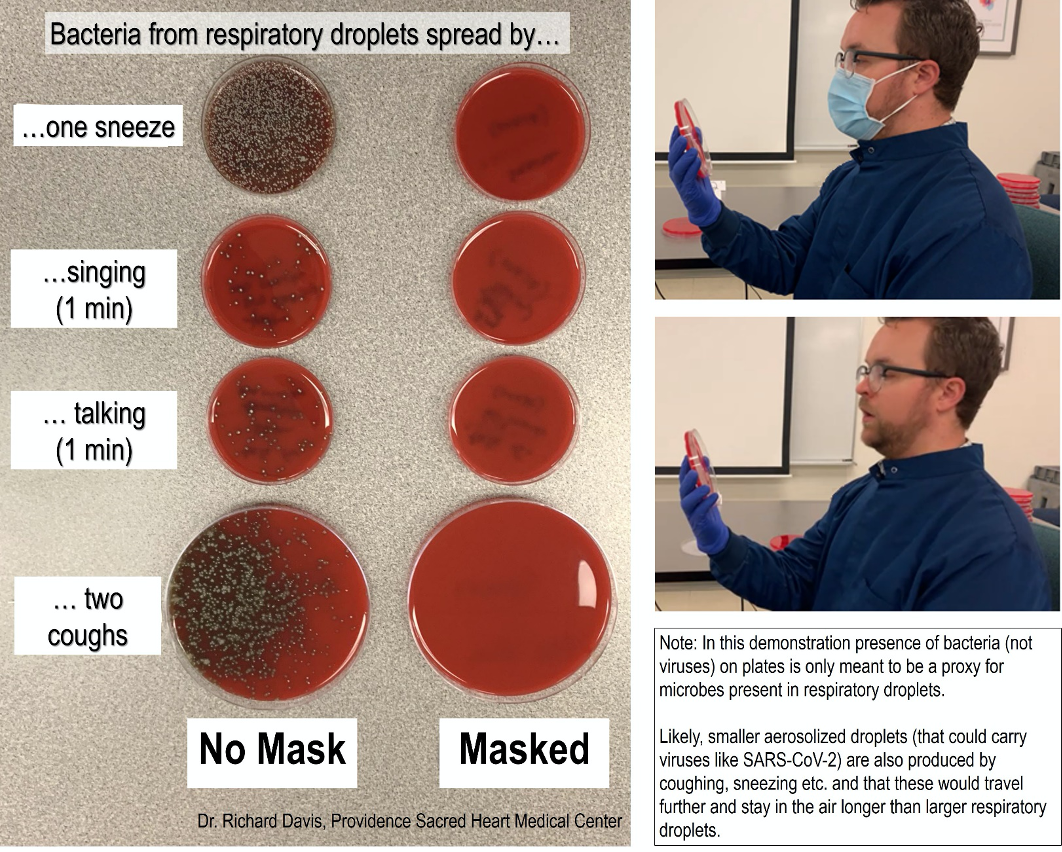NTPA’s Reopening Task Force has invested thousands of hours into research, discussion and review in creating the published “Reopening Protocols” with the objective to minimize risk while continuing activities. It is NTPA’s position that the health value of the performing arts, our “Ten Characters”, and the social and emotional benefits of our student’s experience at NTPA are too important to be “turned off” for what could be six to nine months or longer.
NTPA’s protocol calls for the continuous wearing of masks, safe social distance, vigilance for signs of unhealth, cleaning and sanitizing and other “Best Practices” to minimize the risks.
This page is an informational resources to those trying to better understand the risks associated with singing onstage given some of the discussions and research within the theatre community on two specific singing topics:
- Is it safe to sing onstage or are singers and audience at a high risk of spreading the virus to others?
- Is it safe to sing while wearing a mask?
It is NTPA’s position that it will do all it can to provide detailed information and the best known safety protocols, and will share as much information as we have so that the individual student/parent can best judge their participation.
NTPA’s protocol outlines that productions should evaluate outdoor venues or pre-recording vocals as preferred methods to advance its risk-mitigation strategy. Directors are required to evaluate these options first, taking into account preferences of cast members and parents. Directors must review their show risk-mitigation plan with the Managing Director and must receive his/her approval to sing indoors after they have reasonably exhausted alternatives.
In all cases, actors must wear proper masks at all times, including while delivering lines and singing onstage, backstage and in dressing rooms and deliver to theatres that are generally less than 30% full, and observe the 12-feet “safe social distance” between actors and audience.
In all cases, a student/parent should evaluate on their own their risk of participating and determining the level of involvement they are comfortable with at this time.
Is it safe to sing onstage while wearing a mask?
There has been a great deal of research initiated on the risks of spreading the virus while talking, singing, coughing and simply breathing, and many studies are currently underway to better evaluate the risks.
The concerns for singing are largely as a result of two implications. First, it is believed that the action of singing, speaking loudly, and similar actions can potentially create an “aerosolization” effect whereby the virus can be spread beyond the simple “spray” normally associated with a cough or sneeze.
The more obvious risk of singing versus simple “speaking” in the context of an onstage performance is that while it is rare that a group of people would all “speak” at one time, there will be situations where ensembles of 20+ vocalists may sing at one time, meaning twenty-times the “output.”
What created the focus around singing?
There has been tremendous media coverage of “viral outbreaks” in large choral groups in the early Covid-19 pandemic. Unfortunately, these events took place while we were still learning about the virus and before protections were put in place to minimize the risk of an outbreak.
What is common in each of these “viral outbreaks” is that participants wore no masks, did not fully practice “safe social distance,” were together for hours engaged in group singing in poorly ventilated practice rooms, and in most cases, maintained social contact before and after the gatherings.
As these took place very early in the Covid-19 pandemic, they tended to capture a lot of attention and the immediate reaction was to assume that the singing itself caused the outbreaks.
A review of each of these is available here: Singing Vector Situation Review
The very “visual impact” of wearing a mask
NTPA lead the state and the county in mandatory adoption of mask protections, and the experiment below helps visualize the impact.
This simple study shows very visually the value of a mask in controlling the emission of droplets as well as the similarity between that emission while singing or talking. It should be noted that this study may not fully analyze the impact of aerosols believed by some to be contributory to coronavirus spread.
For the full study, go to: Visual Impact of Masking

Significant Studies on the Risks of Singing During the Pandemic
The studies below provide additional insight to the risks of singing:
- Risk Assessment Of A Coronavirus Infection In The Field Of Music, University of Freiburg, May, 2020. Comprehensive study on the impact of particles spread in various singing and non-singing environments. View Scientific Study
- Press Overview of Preliminary Results. Performing Arts Aerosol Study, Preliminary Results. National Federation of State High School Associations, July, 2020. Comprehensive Study by the National Federation of State High School Associations, preliminary results based on initial weeks of a multi-month analysis. View Preliminary Results of Scientific Study
- Performing Arts Aerosol Study, Means and Methods. National Federation of State High School Associations, July, 2020. Study methodology for the analysis above. View Scientific Study
- Singing in times of COVID-19: more space to the front than to the side. Healthcare in Europe, July 2020. Study concludes singing with a mask acceptable for non-professional environments. View Article on Scientific Study
- “Safer Singing During the SARS-CoV-2 Pandemic: What We Know and What We Don’t”. Journal of Voice, June 29, 2020. Detailed analysis of what information we know and don’t know. View Scientific Journal Article
- International Thespian Society’s Recommendations for Reopening School Theatre Programs: This set of guidelines outlines how music theatre organizations might best manage their environments and NTPA has drawn many of its best practices from this work. View ITS Recommendations
- “Aerosol Emission and Superemission During Human Speech Increase with Voice Loudness” “Scientific Reports” , February, 2019. This technical study evaluates the rising emissions and risks of aerosolization in cases with rising voice levels (not specifically a “singing” study). This study was conducted “pre-Covid-19”. View Scientific Report
Is it safe to sing while wearing a mask?
There has been some debate amongst vocalists and lots of social media angst regarding the potential risks to proper breathing, habit formation and other issue for a vocalist while wearing a mask.
Much of the concern comes from a now generally agreed upon “myth” that wearing a mask creates high levels of unhealthy carbon dioxide, but this has largely been debunked. Others claim that vocalists can place their vocal cords at risk (there is no scientific study that concludes this) or that they might learn “bad habits” while singing in a mask. While perhaps that is possible, the more disciplined singer should be able to avoid that outcome, or reverse those “habits” when this pandemic is over.
Other vocal coaches take the position that to lose a year of practice, training and performance experience and to “wait until the pandemic is over” has a far greater negative impact on a vocalist than any masking health risk.
In all cases, a vocalist is well-served properly resting their voice, drinking plenty of fluids, and avoiding “straining” or over-use, and should take care to not attempt to “compensate” for a mask by louder projections.
The following is a list of materials and commentaries on the subject from around the world:
- https://www.forbes.com/sites/marshallshepherd/2020/07/01/debunking-2-myths-toxic-coronavirus-masks-and-breathing-warms-the-climate/#7188dda430f4
- https://www.usatoday.com/story/news/factcheck/2020/05/30/fact-check-wearing-face-mask-not-cause-hypoxia-hypercapnia/5260106002/
- https://www.healthline.com/health-news/no-face-masks-cant-cause-co2-poisoning
- https://health.clevelandclinic.org/5-myths-about-coronavirus-and-face-masks-debunked/
